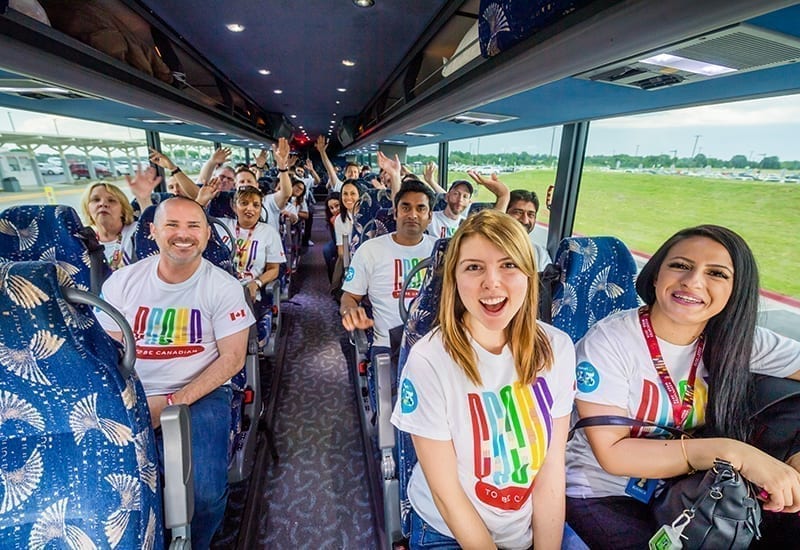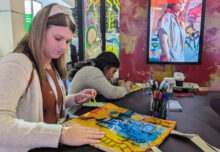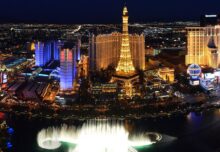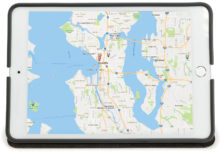Here’s a million-dollar question: Is it time to move the location of your flagship conference?
It’s a topic on a lot of event marketers’ minds following Oracle’s decision to relocate its OpenWorld conference to Las Vegas this September, ending the show’s 20-year run in San Francisco. According to the brand, the move is a result of San Francisco’s exorbitant hotel prices and “poor street conditions” (read: homelessness and open drug use). The move’s economic impact on the city is estimated at $64 million.
The unprecedented news got us thinking—how do brands determine where to plant their conference flags? Should they relocate their flagship events on a rotating basis, or are hometown shows the way to go? And how do you weigh those decisions? Fortunately, we were able to pick the brains of an array of event marketers who make those kinds of calls. Here, we present their top insights.
 More Conference Coverage:
More Conference Coverage:
- A Behind-the-Scenes Look at Walmart’s Associate Week & Shareholders Celebration
- Inside GitHub Universe’s Secrets to Making Attendees Feel Included
TEAM STAY
THE ‘ONE TEAM’ PHILOSOPHY
 Conferences based in a brand’s hometown allow for a large number of employees to attend because they don’t have to hop on a plane to get there. It’s convenient for them, and allows the company to deliver messaging with one voice.
Conferences based in a brand’s hometown allow for a large number of employees to attend because they don’t have to hop on a plane to get there. It’s convenient for them, and allows the company to deliver messaging with one voice.
That mantra rings true for AutoZone’s National Sales Meeting, which is held in its hometown of Memphis each year (LEO Events handles).
“There’s the ability to have everyone from the headquarters building participate so that they can really experience and get to know the other field attendees,” says Lani Glancy, vp-talent development, diversity and communications at AutoZone. “It’s exposure to the culture. It allows everybody to come together at one time and hear from leadership with one voice.”
The same goes for Walmart’s Shareholders Meeting, held annually in Fayetteville, AR. “We are pretty firmly in the camp of getting everybody together once or twice a year is well worth it,” says Mark Henneberger, vp-event solutions at Walmart. “Everyone hears the message at the same time. It’s being part of something bigger than yourself.”
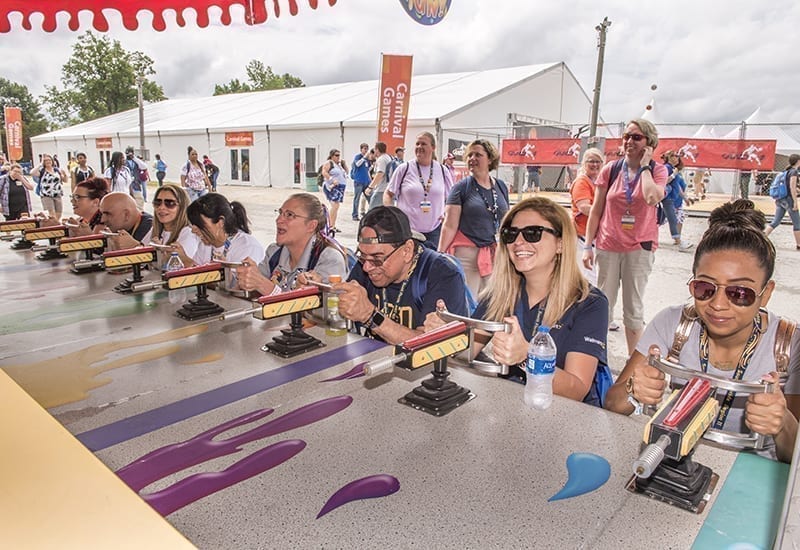
Walmart associates attend the brand’s flagship event each year in its home state of Arkansas.
CULTURAL IMMERSION
Walmart has held its annual Shareholders Meeting in Fayetteville for decades. In fact, in the early days the company’s founder, Sam Walton, and his wife, Helen, hosted a chicken dinner for company associates at their home following the meeting.
The brand’s headquarters is a short car ride away in Bentonville. Both cities contain elements of Walmart’s rich history and culture, which attendees get to experience firsthand when they attend the Shareholders Meeting (LEO Events handles).
“There are clearly great advantages to bringing our associates from around the world and [letting them] experience the brand and the birthplace of the brand, whether they’re touring the home office, or the Walmart Museum or sitting in Bud Walton Arena,” says Henneberger. “So I think there is inherent goodness that comes out—connectivity with these associates that you can’t duplicate in another city.”
INFRASTRUCTURE TALKS
Brands who rely on hometown conferences can be swayed to stay based on the accommodations and updates to infrastructure the city offers. Such is the case for Walmart, which leverages the University of Arkansas to house a majority of the thousands of associates coming to the Shareholders Meeting from around the globe. The university is located within walking distance of Bud Walton Arena, where some of the broader Shareholders Week activities take place.
The same goes for AutoZone’s National Sales Meeting in Memphis, where a $245 million plan to upgrade Memphis International Airport is underway. The city is also in the midst of a $200 million renovation of the Renasant Convention Center, which is slated to be complete this October.
“We’ve been working on this [convention center] transformation for a good while now and it is a vision that has really sparked a whole lot in this city,” says AutoZone’s Glancy.
THE ALLURE OF OFF-SITES
Activities available to attendees outside of traditional conference offerings are a must-have of any b-to-b show, and if a hometown has the goods, that’s just one more reason to stay.
“Memphis is the home of blues, soul and rock ‘n roll. So if you want to do music, this is a great place for that,” says Glancy. “If you want to do food, this is a great place for foodies. If you want to go to the baseball park and take everybody, or rent out the park and do games on the field, you could do that. And of course, we’ve got the [multi-purpose arena] FedExForum. So, there are a lot of different things that a city like Memphis can offer and as an event marketer, those are the kinds of things you’re looking for. How can you bring that level of excitement and differentiation to your program?”

AutoZone cites killer off-sites as a reason to keep its flagship conference in its hometown of Memphis.
TEAM GO
THE DIVERSITY FACTOR
 Switching up the location of a conference can bring a more diverse audience to the event. It’s something Workhuman, a social recognition and performance management platform, relies on while organizing its flagship Workhuman Live conference (Sparks handles). The show is located in a new city each year—a strategy the brand feels passionately about.
Switching up the location of a conference can bring a more diverse audience to the event. It’s something Workhuman, a social recognition and performance management platform, relies on while organizing its flagship Workhuman Live conference (Sparks handles). The show is located in a new city each year—a strategy the brand feels passionately about.
“Workhuman is the outlier of HR conferences and the kind of environment where like-minded people come to connect, have conversations, contribute ideas,” says Jill Kazanjian, director-experiential events at Workhuman. “We want to ensure that we are bringing a diverse group of people to our movement—the varied locations are essential. We incorporate each city’s personality into the event so that our attendees have a better understanding of the region and its people, and that is a huge benefit to our attendees.”
MEETING THEM WHERE THEY ARE
Software company MuleSoft doesn’t leverage its hometown or lean on a particular city for too long when it comes to determining a location for its MuleSoft Connect conference (On Board Experiential handles). Although the show recently transformed into smaller, multi-location events, the strategy is still reliant on data.
“At MuleSoft, it’s all about the data. We go to where the customers are,” says Giselle Umland, senior manager-event marketing at MuleSoft. “We look at our conference data, and we see where our attendees are coming from to understand how we can increase attendance… It’s different when you ask another brand or agency. They might look at a city with attractions like Vegas, but for us, it’s about the attendee data.”
THE SPACE CHALLENGE
Sometimes the decision to relocate a major conference is simply about logistics. Not having enough (or sometimes, too much) hotel or meeting space has prompted plenty of brands to move their shows, including MuleSoft.
“We’ve done a conference in San Jose before,” says Umland. “We looked at San Jose because event spaces at the hotels in San Francisco were a bit too small for us and the convention center was too big for our needs at the time. We decided to go to San Jose then. If you compare San Jose and San Francisco, they don’t have the same attractions. It’s different to sell a conference in San Jose than one in San Francisco, which provides an opportunity of a trip… So we did happy hours with our customers and meetups with fellow developers—more activities to keep them engaged during the conference.”
Workhuman’s Kazanjian agrees: “Like all events, we have to look for our space and sleeping room requirements to be met,” she says. “We prefer locations that have enough contiguous space that we can create a central location where our attendees can learn, network and be inspired. As our conference grows, this is a challenge.”

Workhuman Live moves to a new city every year, a strategy the brand feels passionately about.
(Photo: Steven Miller)
BONUS TIPS: MAKING THE CALL
On the fence about whether or not to relocate your conference? We’ve compiled some key insights from the experts to help inform your decision.
Consider your program needs.
“I think the first thing I would do is consider the conference from the attendee’s point of view,” says Lani Glancy, vp-talent development, diversity and communications at AutoZone. “Is the current venue that they are in meeting their needs and if it’s not meeting their needs, why not? And would a new venue really make a difference, or is it really the program that needs to change?”
Lean on local resources.
“The biggest challenge is learning a new city and selecting the best of the best for our attendees as well as determining how to best use the conference space to create the experience we want,” says Jill Kazanjian, director-experiential events at Workhuman. “It helps to form relationships quickly with local resources, to invest the time to research all of the locations and visit every venue you are
considering.”
Track attendee sentiment.
Simply asking attendees about their conference location preferences and insights can be a huge determining factor in where you host a b-to-b show.
“We track it every year. Generally, it remains positive,” says Glancy. “We try to keep it fresh and make sure that we’re staying aware of the latest and greatest, and attendee activity-tracking… We spend a fair amount of time looking at our agenda and making sure that it’s not the same-old, same-old every year.”
This story appeared in the March 2020 issue

